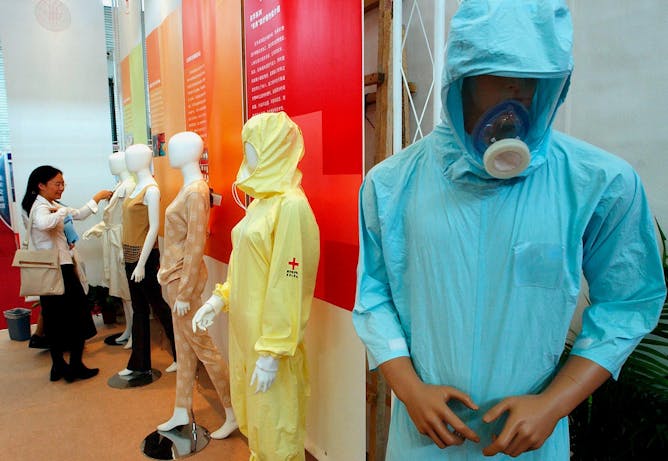|
The coronavirus pandemic underlines the importance of The Conversation’s mission of bringing accurate, timely, research-based information to the public, direct from the experts. We’ve been gratified to see the response: a doubling of readership of our articles and a tripling in the number of scholars offering to write for us.
On this #GivingTuesdayNow, I want to take a moment to ask for your support of this public service. Your gift will help us reach more people with this important information.
And now on to today’s top stories:
|

Visitors look at new anti-SARS outfits for medical workers on display Thursday Nov. 6, 2003 in Shanghai, China, as the country braced for a resurgence. The disease never made a comeback.
AP Photo/Eugene Hoshiko
Marilyn J. Roossinck, Pennsylvania State University
COVID-19 and SARS are both deadly – but different. SARS symptoms were quick to appear, making it easier to contain. Because health officials were able to contain it, the virus died off.
|
Science + Technology
|
-
Austin Nguyen, Oregon Health & Science University; Abhinav Nellore, Oregon Health & Science University; Reid Thompson, Oregon Health & Science University
Researchers from Oregon Health and Science University found that variations in genes that code for parts of the cellular alarm system might play a role in how well people fight off COVID-19.
|
|
Environment + Energy
|
-
Mark Abkowitz, Vanderbilt University
The US faces a high risk of hurricanes and other disasters this year that could leave thousands of people in need of shelter. COVID-19 will make those disasters more dangerous to manage.
-
Deidra Miniard, Indiana University; Joe Kantenbacher, Indiana University; Shahzeen Attari, Indiana University
How should the United States power its economy in 2050? A recent survey finds surprising agreement from Americans of all political stripes.
|
|
Ethics + Religion
|
-
Lee McIntyre, Boston University
What are the moral considerations in making the decision to reopen society while mitigating the risk of infections spreading? We asked a philosophy scholar to walk us through the quandary.
|
|
Politics + Society
|
-
Rebecca Tarlau, Pennsylvania State University
In a Latin American country hard hit by COVID-19, an agricultural collective is stepping in to help where government won't, mounting an astonishing national pandemic response.
-
Brandon Prins, University of Tennessee
In 2019, there were fewer attacks and attempted attacks on ships than there had been in 25 years. The coronavirus may bring economic and political changes that make piracy worse in the coming years.
|
|
Health
|
-
Zhen Yan, University of Virginia
The health benefits of exercise for our mind and body are well documented. But did you know that exercise could lower the risks of the most dangerous COVID-19 complication?
-
Amy Harrington, University of Massachusetts Medical School
An addiction psychiatrist explains why smoking raises the risks from COVID-19 and how to quit.
|
|
Education
|
-
Aaron Metzger, West Virginia University
American teens are much more perceptive about their political world than they are given credit for, a recent study shows.
|
|
Economy + Business
|
-
Lisa Schur, Rutgers University; Douglas L. Kruse, Rutgers University
With vast swaths of society forced to work from home, people with disabilities can overcome many of the challenges they face in a normal office environment.
|
|
From our international editions
|
-
Samuel Cohn, University of Glasgow
Over 30 countries today are making people wear masks in public, despite serious doubts from scientists.
-
Rosie Gibson, Massey University
At times of anxiety and trauma an increase in unusual or vivid dreams and nightmares is not surprising.
-
Gabriela D'Souza, Monash University
Labor's immigration spokesperson Kristina Keneally says immigration has "hurt many Australian workers". The evidence suggests it hasn't.
|
|